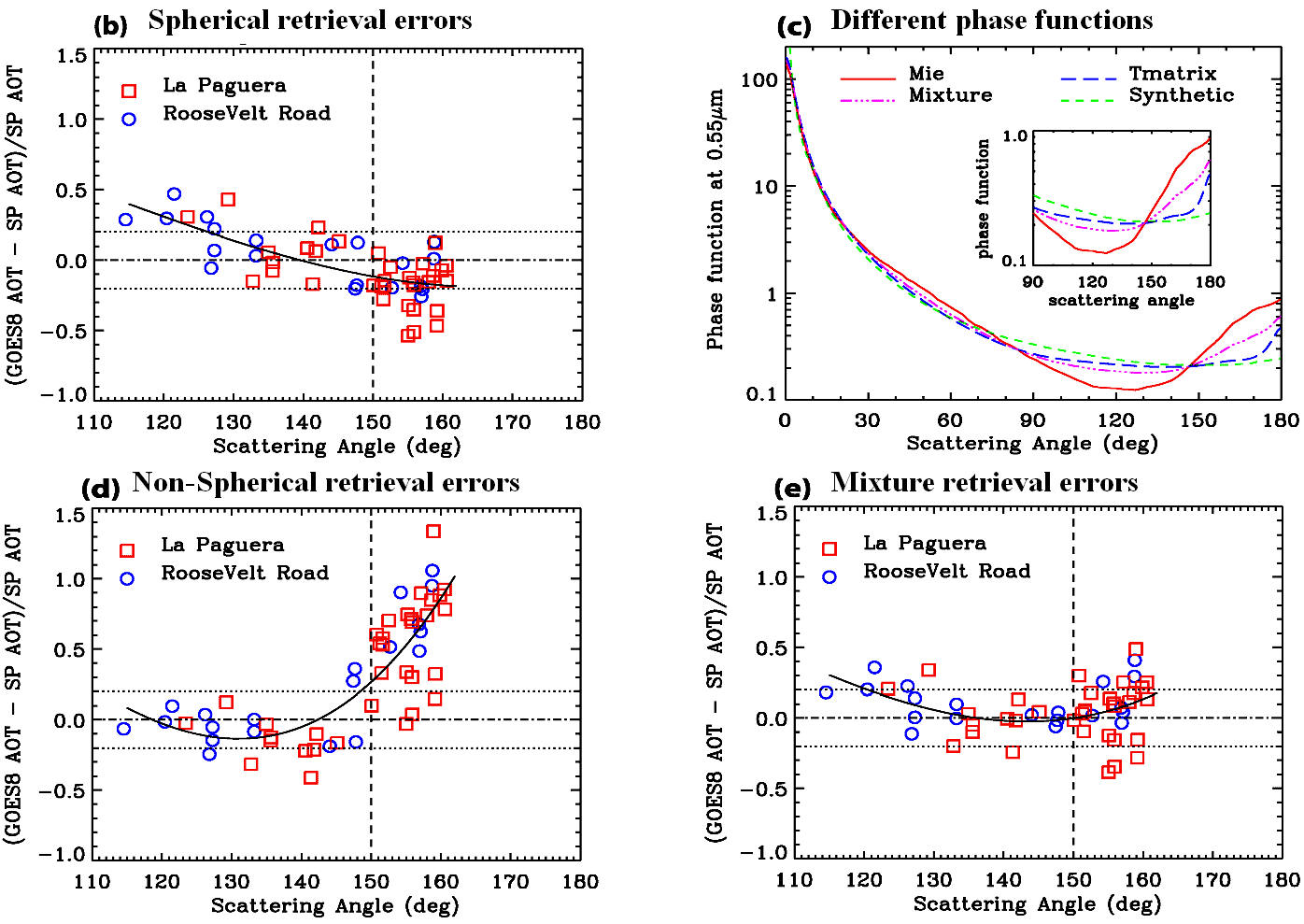Satellite/ground remote sensing of aerosols for monitoring air quality and quantifying aerosol climate forcing and sources. See the following research projects for details.
As part of this project it was defined new top-down approach that spatially constrains the amount of aerosol emissions using satellite (Moderate Resolution Imaging Spectroradiometer (MODIS)) observed radiances with the adjoint of a chemistry transport model (GEOS-Chem). Read related paper
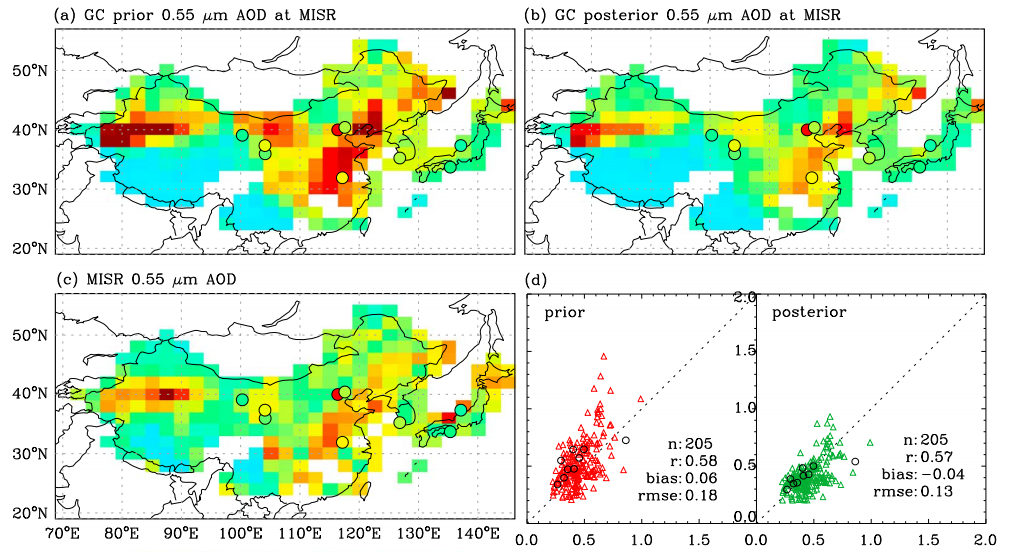
As part of this project a new algorithm, using the Moderate Resolution Imaging Spectroradiometer (MODIS) satellite reflectance and aerosol single scattering properties simulated from a chemistry transport model (GEOS-Chem), was developed to retrieve aerosol optical thickness (AOT) over land in China during the spring dust season. Read paper
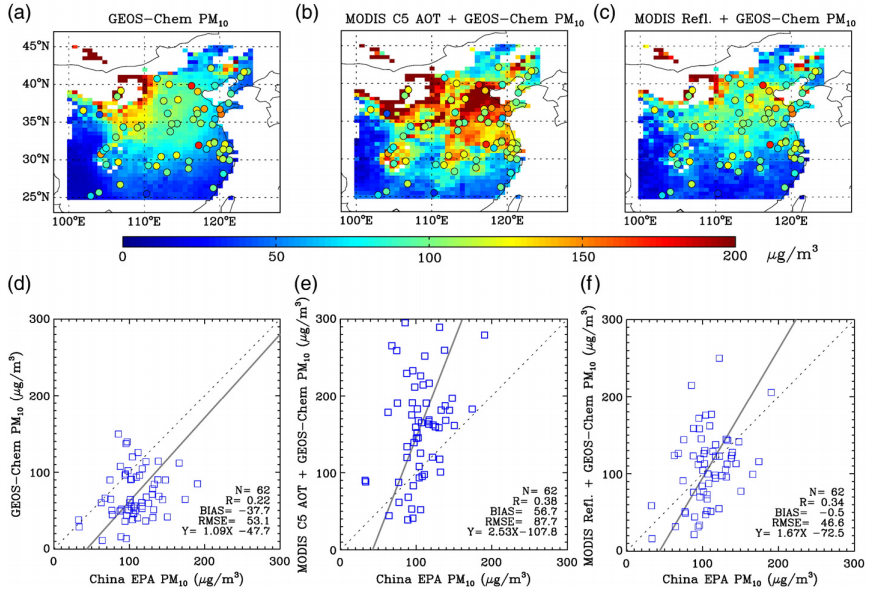
As part of this project A vector radiative transfer model was used in conjunction with the line-by-line radiative transfer model and the database of high-resolution transmission (HITRAN) molecular absorption to simulate the degree of linear polarization of skylight in cloud-free conditions... Read paper
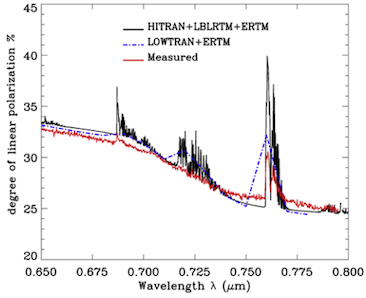
Diurnal Radiative Forcing of Dust Aerosols over the Atlantic Ocean
References:
Wang, J., S.A. Christopher, J.S. Reid, H. Maring, D. Savoie, B.H. Holben, J.M. Livingston, P.B. Russell, and S.K. Yang, GOES-8 retrieval of dust aerosol optical thickness over the Atlantic Ocean during PRIDE, J. Geophys. Res., 108 (D19), doi:10.1029/2002JD002494, 2003. (pdf file)
Christopher, S.A., J. Wang, Q. Ji, and S.-C. Tsay, Estimation of Shortwave Dust Aerosol Radiative forcing during PRIDE, J. Geophys. Res., 108 (D19), 8596, doi:10.1029/2002JD002787, 2003. (pdf file)
Goals:
Some of the goals of this project include:
With the high temporal resolution of GOES8, the diurnal change of dust aerosol forcing can be derived, and more accurate estimation of aerosol forcing on regional climate can be achieved.
Methods:
Using all available in situ measurements to characterize aerosol optical and radiative proprieties. The data used in this study includes aerosol size distribution measurements, light scattering/absorbing coefficients (from Nephelometer), and vertical aerosol profile (aerosol concentration and optical thickness from air-borne instruments).
Create look-up table in which the reflectance at the top of atmosphere is calculated as a function of different surface reflectance, aerosol optical thickness, and different satellite-earth geometries.
A multi-channel threshold method is developed to remove the cloud, and detect dust pixels.
For a cloud-free pixel, the AOT is retrieved by finding the best bit between GOES8 reflectance and the pre-calculated reflectance in the look-up table. The validation is performed by comparing GOES8 with ground-based and air-borne Sunphotometer measured AOTs. A good agreement was found.
To calculate the dust radiative forcing, the broad-band dust optical properties are further derived from the mutli-spectral aerosol optical thickness inferred from AERONET Sunphtometer.
Using derived dust optical properties and a house-modified delta four stream radiative transfer model, we found an excellent agreement between calculated and measured downward shortwave fluxes (including global, direct, and diffuse components), which ensure the reliability of further using GOES8 AOT to calculate dust forgings.
Results:
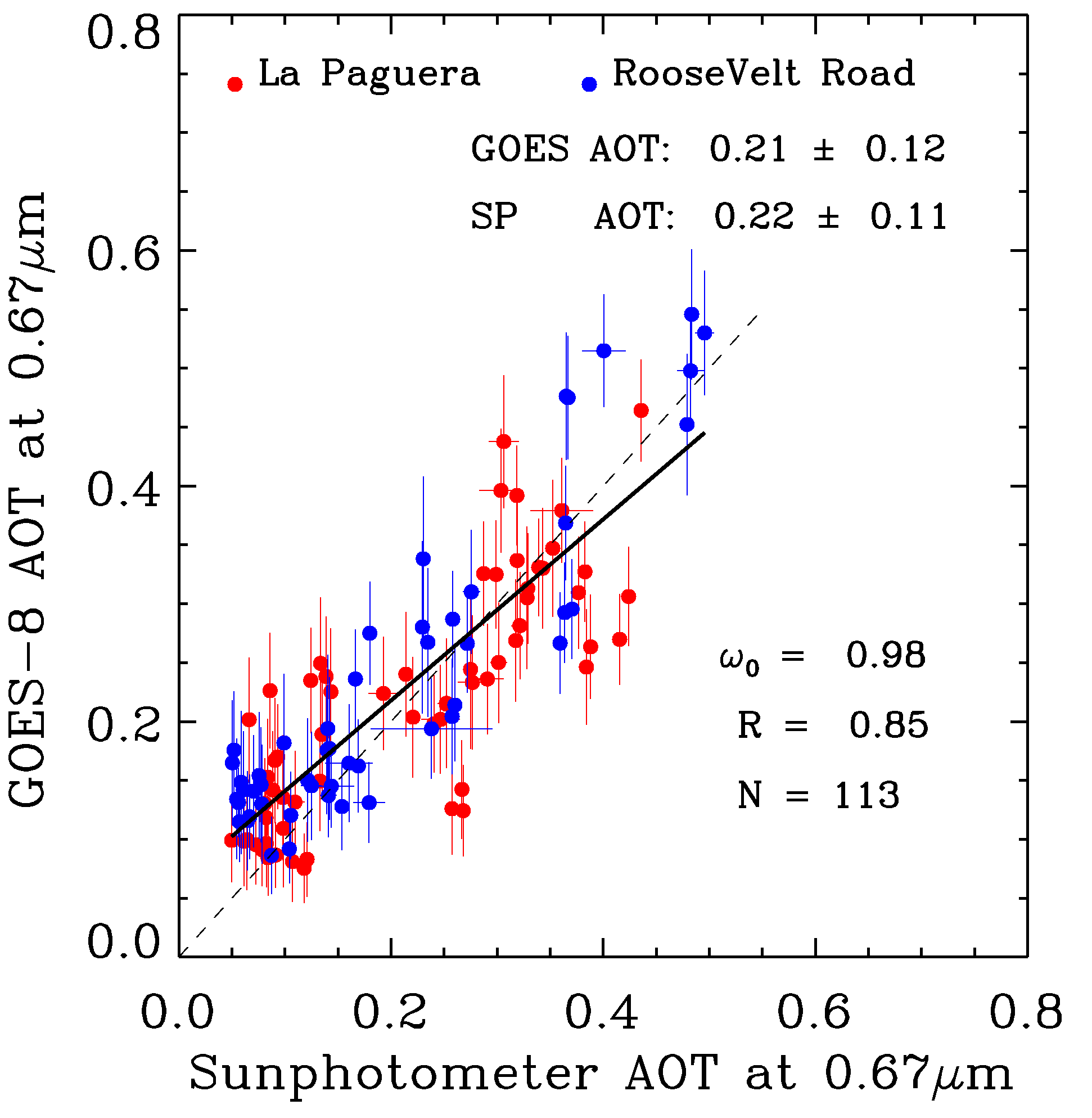
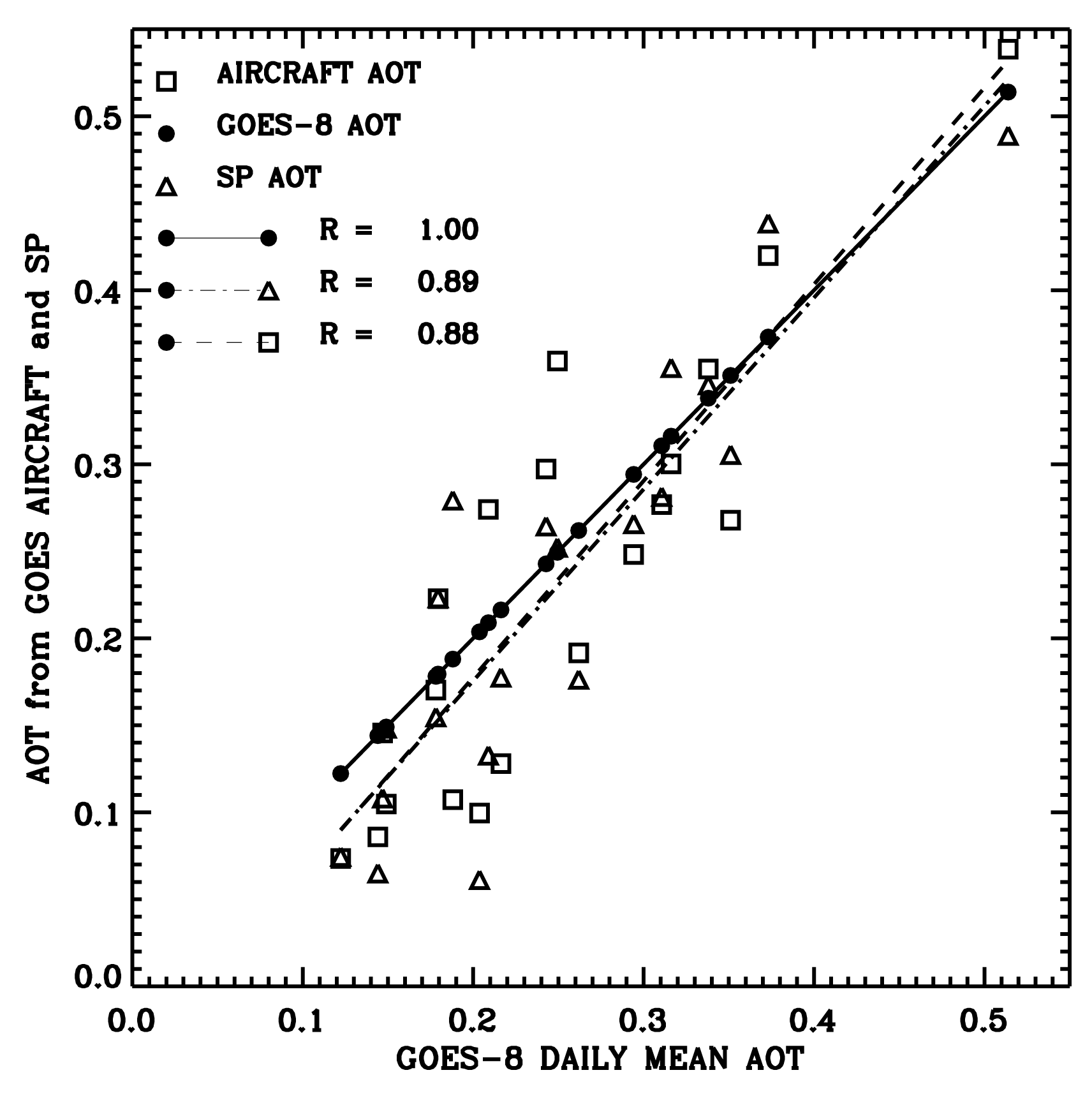
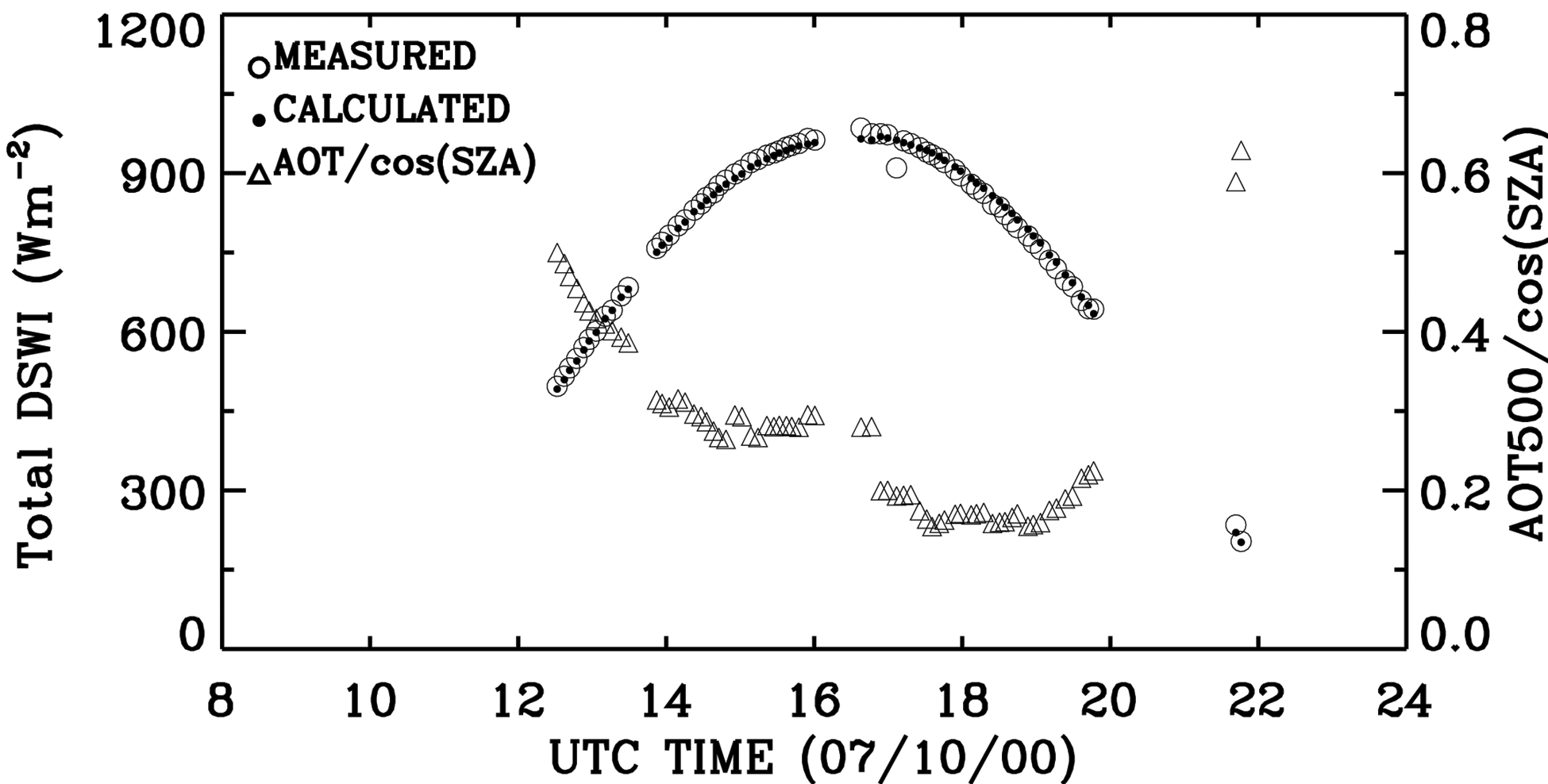
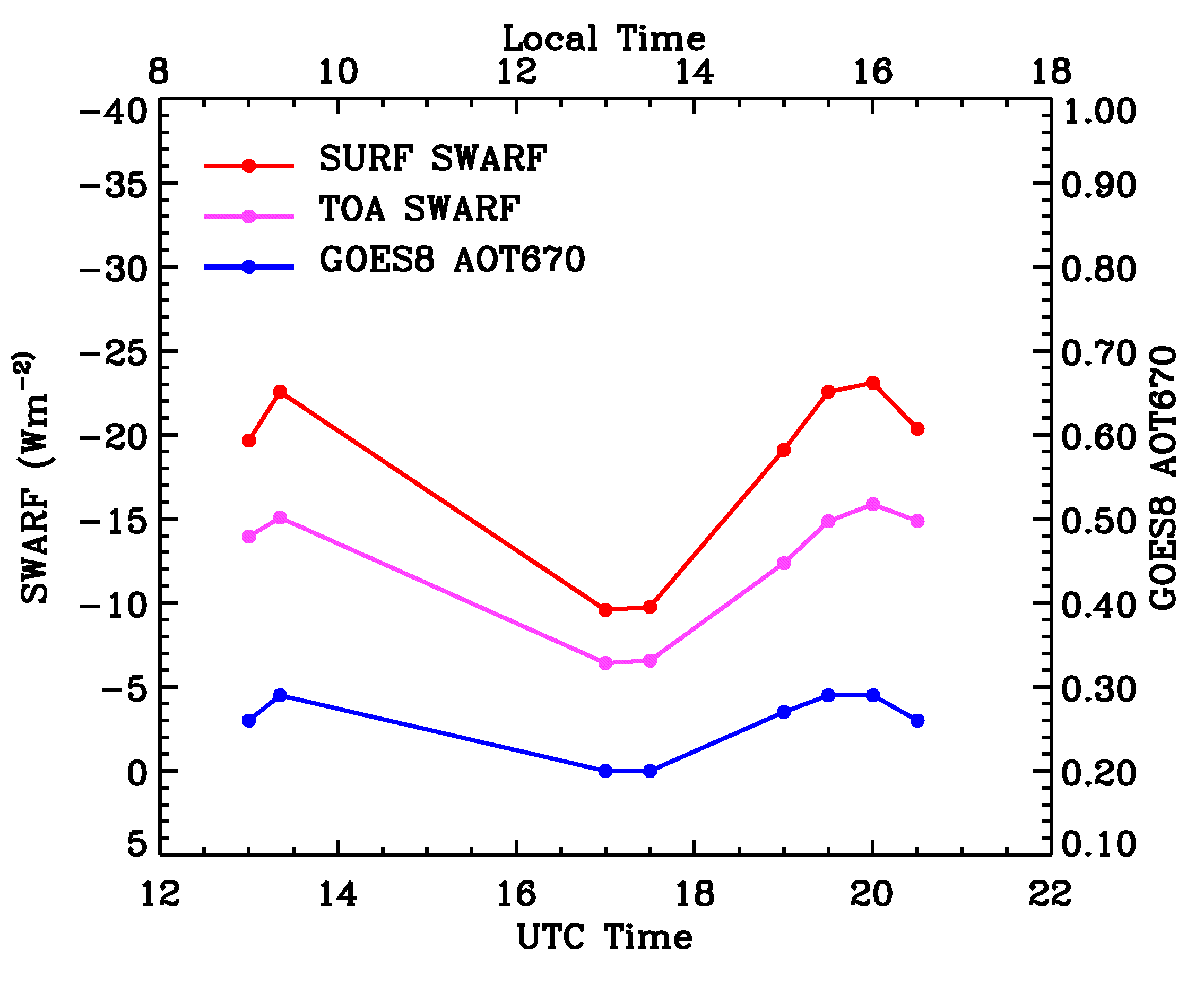

Diurnal Change of Aerosols Optical Thickness in East Asia Retrieved from Geostationary Meteorology Satellite (GMS)
Reference:
Wang, J., S.A. Christopher, F. Brechtel, J. Kim, B. Schmid, J. Redemann, P.B. Russell, P. Quinn, and B.N. Holben, Geostationary Satellite Retrievals of Aerosol Optical Thickness during ACE-Asia,J. Geophys. Res., 108 (23), doi:10.1029/2003JD003580, 2003. (pdf file).
Observations show that dust aerosols from the Takla Makan and Gobi deserts in northwest China can be transported to Korea, and even across the Pacific Ocean to the United States [Husar et al., 2001, Herman et al., 1997] and Canada [McKendry et al., 2001]. Due to rapid economic growth, the emission of industrial pollutants has increased in the East Asian regions [Bergin et al., 2001].
The aerosols in this region include sulfate, dust, soot and sea salt, in a highly mixed condition, producing a complex aerosol loading in the troposphere. Some studies have shown that aerosols might be an important factor for the regional cooling in the Sichuan basin in Southern China [Luo et al., 2001; Li et al., 1995] and drought in northern China [Menon et al., 2002]. Since there are few observations available over the oceans, satellite measurements, due to their large spatial coverage (e.g, polar-orbit satellite) and high temporal resolution (e.g., geostationary satellite), provide a unique tool for quantifying aerosol properties and spatial distributions. However, to reliably retrieve aerosol properties from satellite measurements, ground and aircraft measurements are needed to constrain the satellite retrieval processes and validate the satellite results. This study demonstrates such a strategy, with emphasis on estimating the day-time diurnal change of aerosol radiative forcing, by using geostationary satellite data and other measurements during the ACE-Asia Intensive Observation Period (IOP), April 01-April 30, 2001. ACE-Asia was conducted off the coast of East China, Korea, and Japan from late March to early May 2001. A detailed description of this campaign is given by Huebert et al [2003]. In contrast with the time-invariant aerosol models used in previous satellite retrieval studies [e.g.,Wang et al., 2003; Rao et al., 1989], aerosol properties in this study are calculated as a function of space and time (called the dynamic aerosol model) by incorporating an aerosol climatology for East Asia as well as observed aerosol properties from ground and in-situ measurements during ACE-Asia. The detailed description of the retrieval method and validations of the retrieval algorithms can be found in the reference listed above. The following is the case demo of our AOT product.
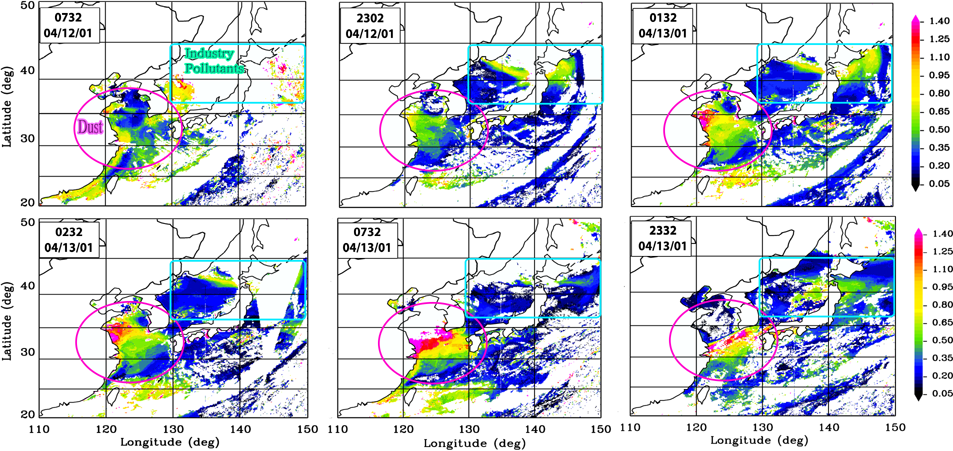
Exploring the Potential of Satellite Data for Air Quality Applications
References:
Wang, J., and S.A. Christopher, Intercomparison between satellite-derived aerosol optical thickness and PM2.5 mass: Implication for air quality studies, Geophys. Res. Lett., 108 (21), doi:10.1029/2003GL018174, 2003.(pdf file)
Christopher, S. A. and J. Wang, 2003: Exploring the Potential of Satellite Data for Air Quality Applications, Eos Trans. AGU, 84(46), Fall Meet. Suppl., Abstract A11E-0033, 2003. (pdf file, download first and then open it).
1. Introduction
Particular matters, or aerosols, reduce visibility, affect human health, and
also cause several ecological effects. As defined by Environment Protection
Agency (EPA), the dry mass content of particular matter with aerodynamic
diameter less than 2.5 µm (PM2.5) in the atmosphere is an important parameter
for the evaluation of air quality. However, the large spatiotemporal variations
of particular matter make it a challenge to judge the air quality and issue
prompt health alert from the current ground-based measurement network,
especially when the aerosol events come from sources outside the U.S. The launch
of EOS TERRA and AQUA satellite provides an unprecedented opportunity to monitor
the air pollution over the globe. The intent of this study is to explore the
potential of satellite aerosol datasets for air quality applications.
2. Hypothesis and Methodology
Aerosols with diameters around 1 ~2µm are efficient in scattering the visible
light. During MODIS passing time (locally, 10:30AM for TERRA and 1:30 for AQUA)
in clear sky conditions, the atmospheric boundary layer is well mixed. Hence,
the MODIS visible reflectance and its column aerosol optical thickness (AOT)
retrievals can be used as indicators of the PM2.5 mass at the surface. In this
study, we compared MODIS AOT with the ground-based PM2.5 hourly measurements.
For each comparison, MODIS AOT time is centered around the PM2.5 observation
time period. The final goal of this comparison is to evaluate the quality of
MODIS AOTs in the context of air quality applications before they are
assimilated into the air quality models. This is important because
evaluation of data quality is a critical step in the data assimilation
processes.
3. Data and Study Area
4. A Case Demo. (more cases and analysis can be found in our paper and poster)
The following figures show a heavy
haze event identified by the spatial distribution of MODIS AOT. Also shown
is the linearly derived Air Quality Index (AQI) and the 700mb geopotential
heights. Grey regions are areas where MODIS AOT is not available due to
possible sun glint or cloud contamination.
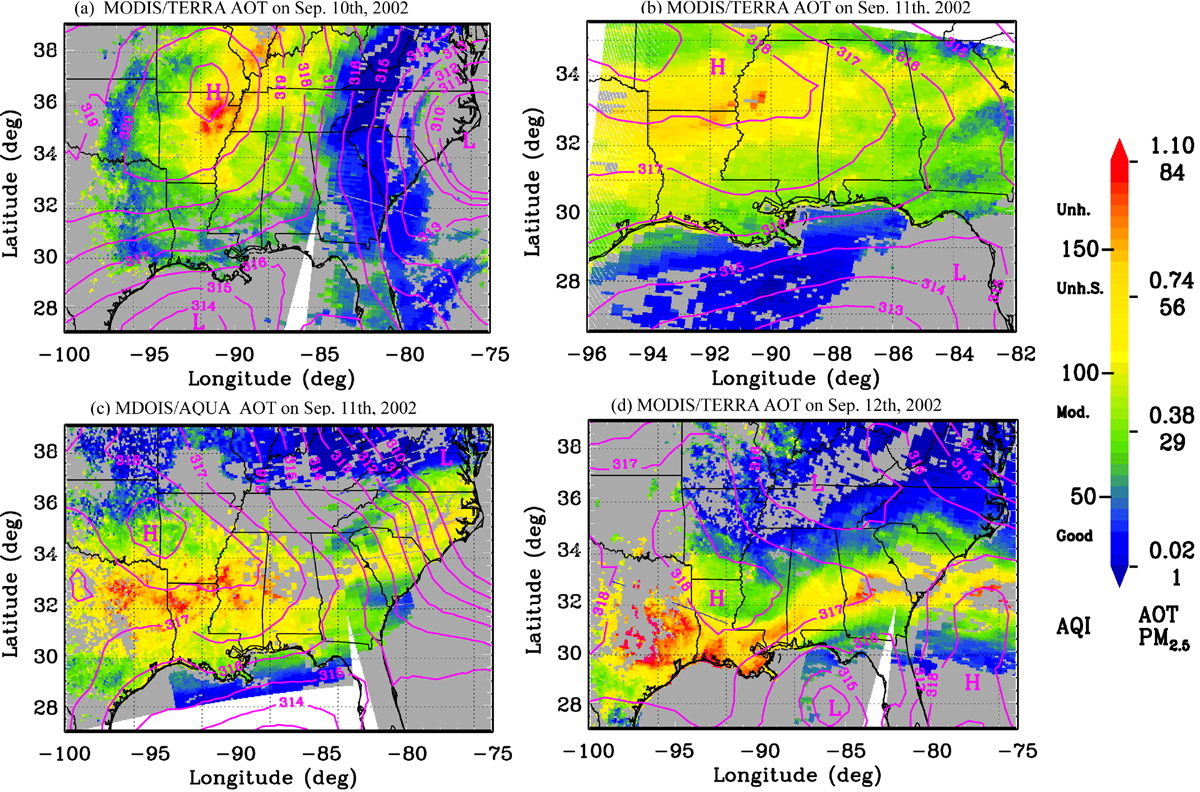
5. Conclusions
Diurnal Variability of Dust Aerosol Optical Thickness and Angstrom Exponent over Dust Source Regions in China
Collaborated with Drs. X. Xia and P. Wang in the Institute of Atmospheric Physics, Chinese Academy of Sciences, We recently wrote a paper on the dirunal variability of dust optical properties over the dust source regions in China. The paper has been accepted for publication in Geophys. Res. Lett. Here is the reference of the paper: Reference:
Wang, J., X. Xia, P.Wang, and S. A. Christopher, Diurnal Variability of Dust Aerosol Optical Thickness and Angstrom Exponent over Dust Source Regions in China, Geophys. Res. Lett., 31, 10.1029/2003GL019580, 2004. (pdf file).
The following are some brief descriptions and highlights.
1. Major finding
Using 22 months of Aerosol Optical Thickness (AOT) data
collected from a Sunphotometer located near the Takalamakan and Gobi dust source
regions (Dunhung, 40.09°N, 94.41°E) in 1999 and 2000, we examine the diurnal and
seasonal change of dust AOT and Angstrom exponent. Most dust events are during
the Spring through early Summer months and our analysis shows a season-invariant
diurnal change of more than ±10% for AOT and ±30% for Angstrom exponent,
with larger AOT and smaller Angstrom exponent values late in the afternoon. Our
results are different and complimentary to recent studies [e.g., Smirnov et
al., 2002; Kaufman et al., 2000] that have reported a much smaller (±5%)
diurnal variability of dust AOT over various AERONET sites where dust is a major
contributor to AOT, but lacked the long-term observation data in the Chinese
dust source regions. Large diurnal changes of AOT and Angstrom exponent may be
significant enough to be carefully considered in radiative forcing, air quality
and numerical modeling studies.
2. Why do we concern about the dust optical properties,
especially in East Asian dust source region?
The effect of aerosols on climate is one of the largest uncertainties in current
global climate models [Hansen et al., 1997]. Current
understanding of the radiative forcing of dust aerosols is limited, especially
over dust source regions where ground observations are sparse and polar
orbiting, multi-spectral satellite retrievals at visible to near-infrared
wavelengths are often difficult due to the high surface albedo [Kaufman et
al., 2002]. While several studies and field experiments have been conducted
to study Saharan dust aerosols [Tanré et al., 2003], the widely
prevalent dust events ("yellow sand") from the Taklamakan and Gobi deserts in
Northwest China, have only gained attention recently [e.g. Husar et al.,
2001]. In addition, previous experiments such as ACE-Asia [Hubert et al.,
2003] examined aerosol properties thousands of kilometers downwind from the
Taklamakan and Gobi deserts. To our knowledge, no long-term or mid-term
systematic observations of dust radiative properties in the dust source region
over China have been presented.
Using AOT data from the Aerosol Robotic Network (AERONET), recent studies have
indicated that the diurnal variability of dust AOT is small (<5%) over various
observation sites such as Cape Verde [Kaufman et al., 2000; Smirnov et
al., 2002] that is about 500km downwind from the Saharan dust source region.
On the other hand, several cases studies from both ground observations [e.g.,
Levin et al., 1980] and geostationary satellite retrievals [e.g., Wang
et al., 2003] indicate that the diurnal variation of dust aerosols is
relatively larger (>15%) and are important for dust radiative forcing
calculations [Christopher et al., 2003]. Our current study is different
from previous research since we use Sunphotometer inferred aerosol optical
thickness (SP AOT) data collected near the Chinese dust source regions over a
longer time period to analyze the diurnal and seasonal variations of dust AOT
and Angstrom exponent.
3. What makes our observation site and this study unique?
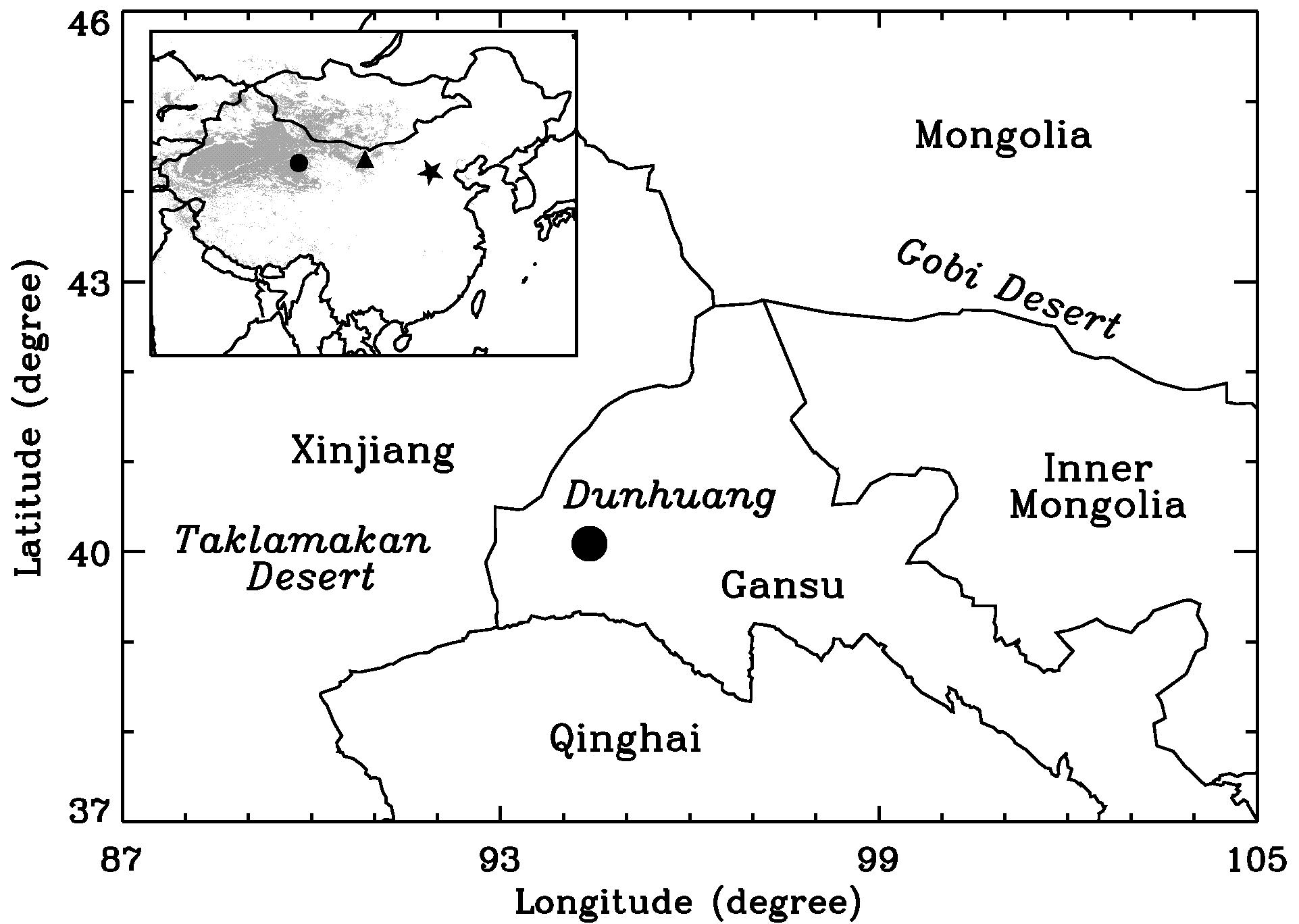
However, in some time, the cold high pressure from Siberia could entrain the
Takalamakan dust (and sometime also small portion of Gobi desert) westward to an
elevation larger than 5000m, and then further northward to the 50°N
where ultimately dust would be transported by the westerly just stream to the
North Pacific Ocean [Sun et al., 2001]. In either case, Dunhuang is
affected by dust storms. The elevation (above the sea level) of Dunhuang city
is about 1400 meters, the annual relative humidity is about 40%, and annual
precipitation is less than 16mm. Such geographical and meteorological
characteristics of the Dunhuang observation site are different when compared
with Cape Verde (16.72°N, 22.93°W) that is commonly used to study Saharan dust
properties.
4. Please find the analysis results in our paper.
Reference: Wang, J., and S. T. Martin, Satellite characterization of urban aerosols: Importance of including hygroscopicity and mixing state in the retrieval algorithms, J. Geophys. Res.,doi:10.1029/2006JD007705, accepted, 2007. (pdf file)
1. Motivation
Satellite retrieval of aerosols is an inversion problem. Assumption of surface
reflectance and aerosol optical properties (such as single scattering albedo and
phase function) have to be pre-described during the computing of look table that
links the satellite-measured reflectance with those retrieval parameters such as
aerosol optical thickness and effective radius. In this paper, we investigate
how the retrieval accuracy can be affected by those assumptions, in particular,
the assumption on urban aerosol optical properties.
Recent field experiments in
India and Mexico city have shown that the urban aerosols are most likely
composed of internally mixed black carbon and sulfate-nitrate aerosols, and
their single scattering albedo can be as low as 0.80 or smaller and is sensitive
to the ambient relative humidity.
In here, we investigate how the aerosol mixing state and ambient relative
humidity, which is neglected in the majority of aerosol retrieval algorithms,
will affect the retrieval accuracy of aerosol optical thickness and size.
2. Results (see details in the manuscript)
The following figure shows the isopleths of the ratio of the retrieved aerosol optical
thickness assuming external mixing with optical properties at 70% RH to that
assuming internal mixing with optical properties at either 70% RH or variable
with RH.
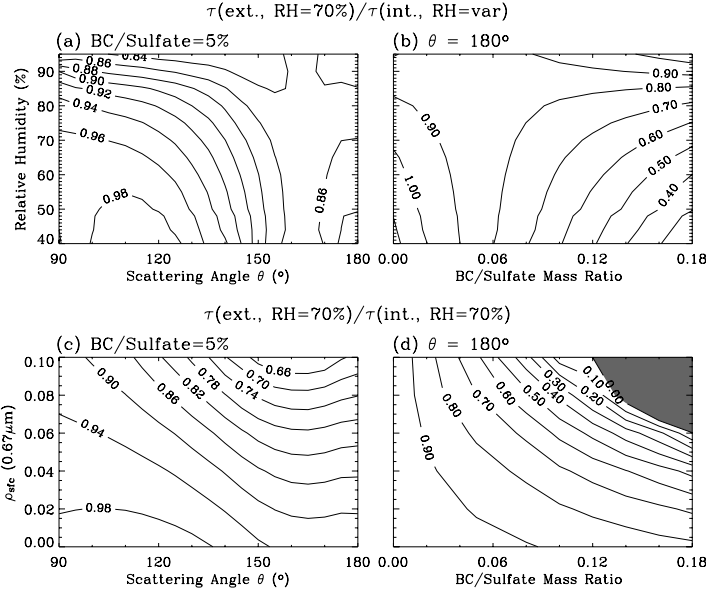
The Effect of Non-Sphericity on Geostationary Satellite Retrievals of Dust Aerosols
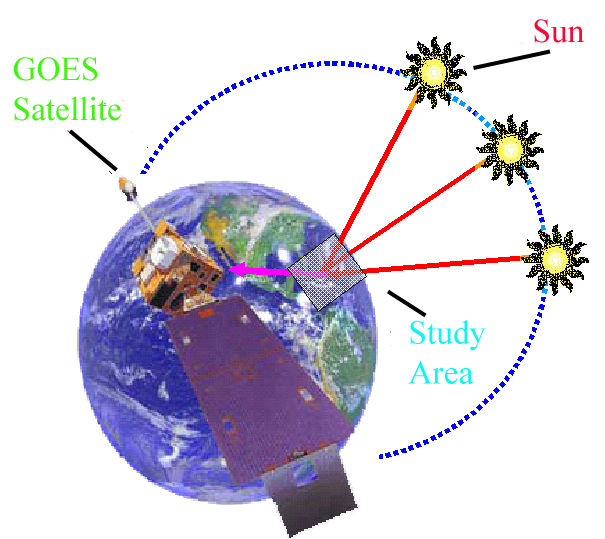
Collaborated with Drs. Xiong Liu (Harvard University), Jeff Reid (NRL),
and Hal Maring (Miami Univ.),
Sundar Christopher
, and I recently published an article in GRL on
the dust non-sphericity effect in the satellite aerosol retrievals.
One advantage in using geostationary
satellite data is its high temporal resolutions. It revisits the same area
every 30 minutes, and the change of solar zenith angle for a certain
location provides an opportunity to examine the satellite retrievals over a
wide range of scattering angles, even for the same dust layer on the same
day. (see conceptual figure on the left).
Details can be found in our paper and recent poster:
References:
Wang, J., X. Liu, S.A. Christopher, J.S. Reid, E.A. Reid,
and H. Maring, The effects of non-sphericity on geostationary satellite
retrievals of dust aerosols, Geophys. Res. Lett., 30,
doi:10.1029/2003GL018697, 2003.
(pdf file)
Wang, J., S A. Christopher, Xiong Liu, Jeffrey S. Reid,Elizabeth Reid, Hal Maring.
The effect of non-sphericity on GOES-8 dust aerosol retrievals during PRIDE,
Eos Trans. AGU, 84(46), Fall Meet. Suppl., Abstract A11E-0011, 2003.
(pdf
file, download first and then open it)
1. Background
2. Objectives
Will consideration of non-spherical effects improve the satellite retrievals,
if all the required data to characterize aerosol optical properties are given
in the same temporal-spatial domain?
3. Methods/Strategies
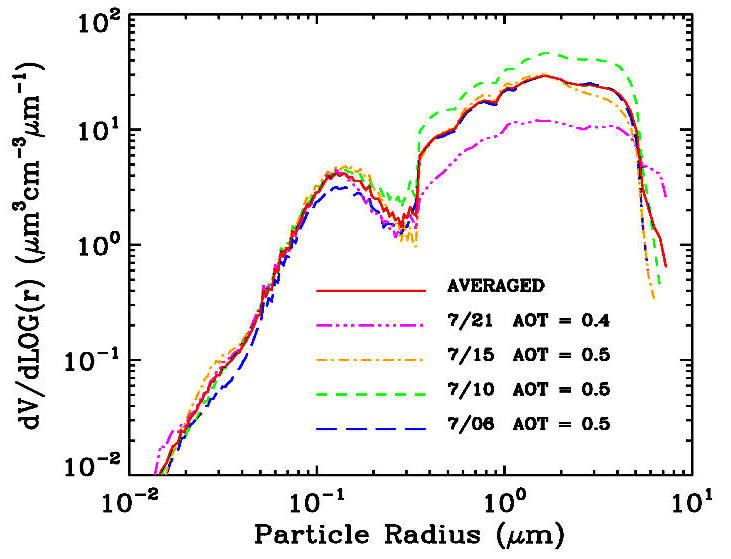
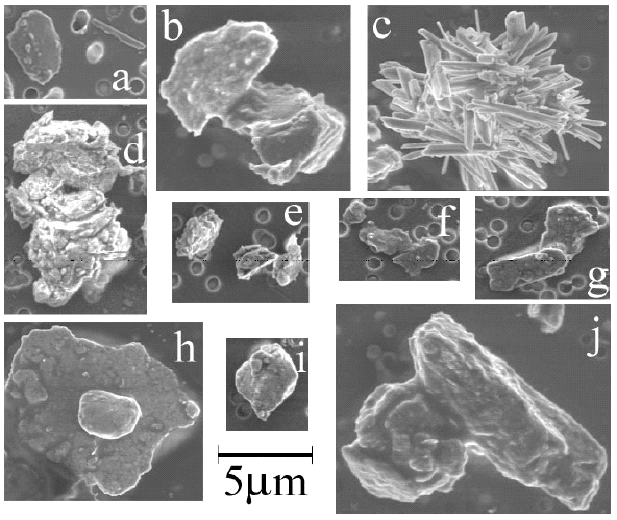
4. Results and Conclusion
The retrieval results using different phase functions are shown in the
following figure. Here listed some conclusions.
